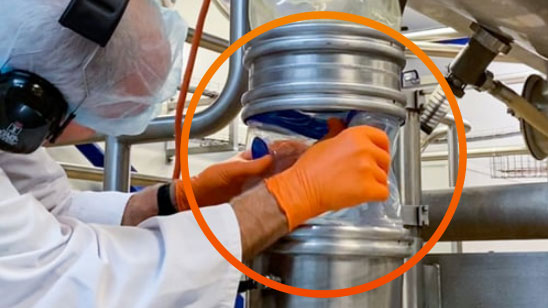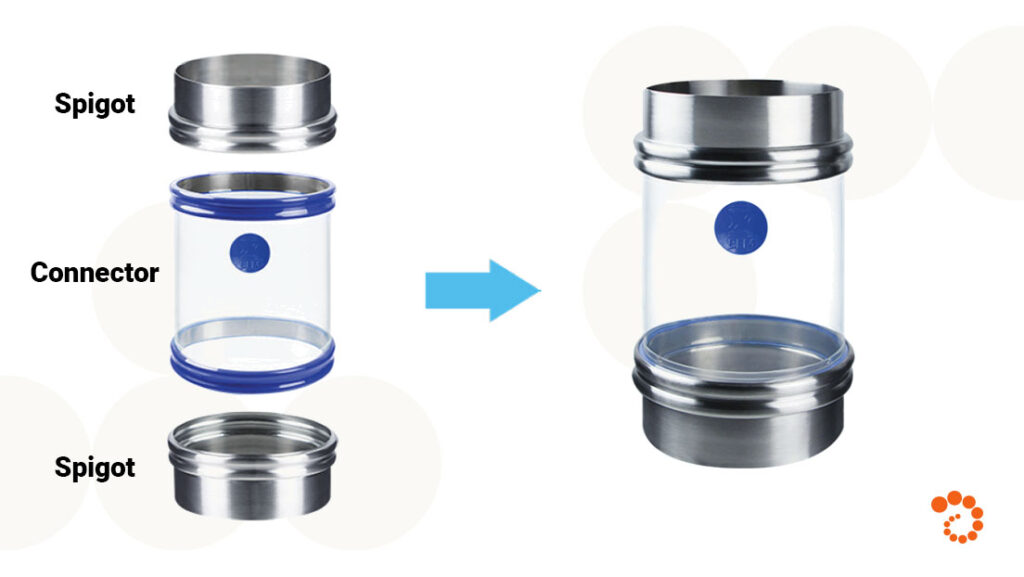BFM® Fitting 101: A Comprehensive Guide

Understanding BFM® Fittings: Components and Materials
BFM® is best known for their flexible connectors. However, they offer a diverse range of power processing solutions, including breather bags, blanking caps and weighing bellows. What sets BFM® fittings apart is their snap-in design. This patented system consistently ensures a perfect fit, eliminating the need for time-consuming adjustments and reducing the risk of leakage.
Most BFM® flexible connectors are designed to replace traditional hose clamp connectors in powder processing equipment. Their unique design creates a 100% sealed system, improving overall process efficiency. BFM® flexible connectors consist of two primary components:
- Spigots: metal adapters that attach to your existing equipment to provide a secure base for the sleeve connection.
- Sleeves: a flexible tube that connects two spigots, creating a sealed pathway for powder transfer.

BFM® fittings are available in various materials to suit different manufacturing needs. The choice depends on factors like operating temperature, chemical compatibility, and abrasion resistance requirements. Applicable across various industries, including food, pharmaceuticals, and chemicals, some examples include:
- Seeflex 040E Connector: Made from a clear ether-based thermoplastic polyurethane alloy, making it very strong and flexible; ideal for use on sifters, sieves, screeners, feeders, bin discharges, hoppers & conveyors.
- Seeflex 060ES Connector: Pressure-resistant connector made from a clear, ether-based thermoplastic polyurethane alloy with polyester scrim.
- Teflex Woven Connector: Made from pure woven PTFE and can be used in high temperature applications and with caustic or acidic products.
- Weighing Bellows: Ideal for preventing vibration transmission between equipment, minimizing any transfer that can affect weighing or scales downstream.
- Kevlar Cover: A flame-retardant cover that fits over existing connectors, typically used in over-pressure and potentially explosive applications to reduce the risk of fire.
By familiarizing yourself with these components and materials, you can make informed decisions when selecting the right BFM® fitting for your specific powder processing needs.
Selecting the Right BFM® Fitting
There are several considerations to make when selecting the right BFM® fitting for your unique needs:
- Operating Conditions: Conduct a thorough assessment of your equipment configurations and process parameters. Consider temperature ranges, material flow characteristics, and abrasiveness of the product. When connecting components with dynamic movements, such as a vibrating sifter to a hopper, precise measurements are critical. Account for the full range of motion to determine the optimal connector length. Insufficient length may result in potential tearing, while excess length can lead to product accumulation.
- Pressure and Size: Consider system pressure dynamics, particularly in pneumatic conveying applications. Select fittings capable of maintaining seal integrity under variable pressure conditions to ensure consistent performance. Accurate sizing is crucial. Measure connection points precisely and allow for any equipment movement.
- Compatibility and Compliance: Ensure the chosen fitting is compatible with your existing equipment and the materials being processed. Verify that the fitting meets all relevant regulatory compliance and safety standards for your industry (FDA, USDA, etc.).
The selection of an appropriate BFM® fitting requires comprehensive analysis of system requirements and operational parameters. For help selecting the right fittings, talk to one of our engineering experts.
BFM® Fitting Customization

Fittings can be customized to accommodate non-standard equipment configurations, atypical dimensional requirements, or specific material performance criteria. These may include specialized flange geometries, corrosion-resistant alloys, non-conventional angular orientations, or custom-designed transitions. Tailored solutions such as these help you address complex operational challenges in powder processing systems.
The customization of BFM® fittings requires specialized expertise in powder handling dynamics, materials science, and precision manufacturing processes. Collaboration with experienced professionals is essential. Technical specialists, such as those at Powder-Solutions, Inc., provide comprehensive guidance throughout the customization process. Our expertise ensures that custom fittings not only meet your specific operational requirements but also adhere to the stringent performance and safety standards associated with BFM® fittings.
Powering Your Process with the Right BFM® Fittings
While flexible connectors and fittings may be a small part of your processing system, there’s a lot to consider — from material and pressure to sizing and compliance. Once you find the right BFM® fittings, however, the benefits speak for themselves. Consult with an engineering expert at PSI to get started toward a cleaner, safer, and more efficient facility.


